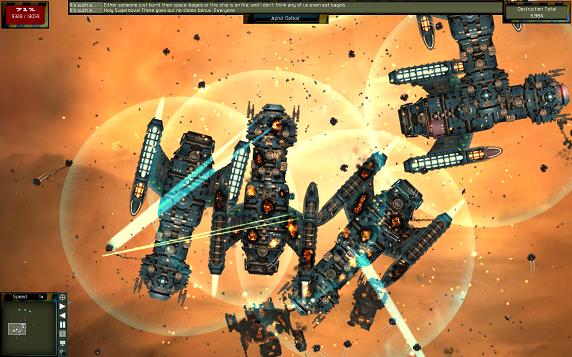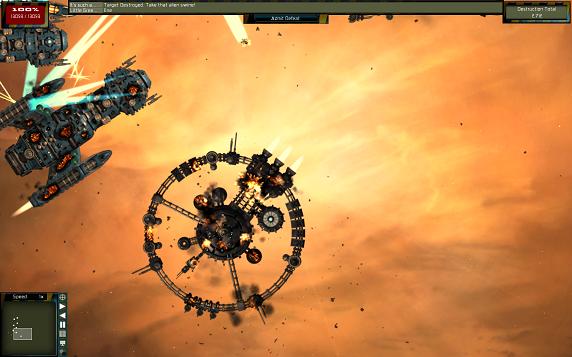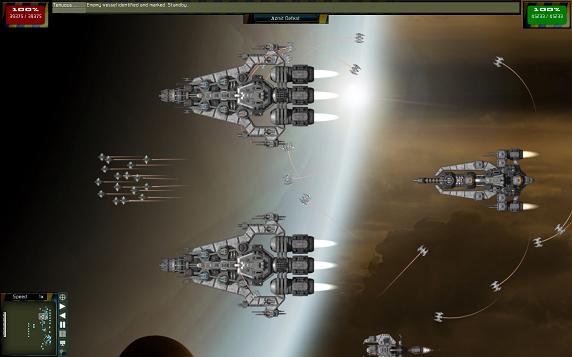This was one of the games I picked up for cheap during the Christmas sales on Steam. It’s made by Cliff Harris of Positech Games, who’s a QT3 regular notorious for his anti-piracy tirades, but this is the first game of his that I’ve bought. Gratuitous Space Battles is a game about combat between opposing fleets of starships. There’s no grand strategic layer here. Two fleets meet on what is essentially a 2D battlefield seen from a top-down view and one fleet flies away as the victor.
What sets this game apart is that you don’t even get to control the individual ships directly. Instead you spend most of your time on the ship design screen, picking hulls from one of three classes, fighter, frigate or cruiser, and outfitting it with the modules and weapons you want. Higher quality gear costs more money of course, and you also need to make sure that your ship generates enough power to supply all of the systems it’s equipped with and enough personnel to crew them. Weight is another consideration as engines generate thrust but the actual speed of the ship is determined by a combination of thrust and the total weight of the ship.
Once you’ve created a library of ship designs that you think will be effective, you go into the actual battle maps and deploy your ships. Each map gives you a fixed budget to play around with as well as a limited number of pilots, meaning that you can only have so many ships in total. Many maps also impose special rules and conditions, such as reducing the strength of all shields by half or even eliminating them altogether, disallowing the use of fighters or restricting the range of all weapons.
On the deployment screen, you decide which ship designs to use in the battle, how many of each to use within the resource limits of the map and where to deploy them. You can also give them orders and target priorities, so if you make an anti-fighter frigate you could set it to target fighters at 100% priority and to escort a cruiser in the battle. Other possible commands to use include the ever useful cooperative command which instructs your ships to target enemies that other friendly ships are already shooting at and vulture which tells your ships to open fire on the most heavily-damaged enemy ships.
This is actually the only place where you can issue orders to your ships at all. Once you click the Fight button to start the battle, the only thing you can do is to observe the unfolding carnage and try to assess how your ship designs and battle plans are doing against the enemy fleet. There are time compression tools to speed up or slow down the action and you can click on your own ships to see how much damage they’ve taken, but that’s the extent of the interactivity available to you. After the battle, win or lose, you’re shown a report of how your ships did including statistics like how accurate your shots were and how efficiently your defenses deflected or absorbed the enemy’s weapons.
All of this sounds quite enticing but I ended up being somewhat bored and disappointed with the game. For one thing, it has a lot of bugs and feels distinctly unpolished. I had to click several times on the button on the deployment screen that shows the supplies available for the map to get it to work and the game often crashes when you do something it didn’t expect. But the main problem is that the game simply isn’t tactically rich enough. There are no firing arcs for example even for the largest weapons and shields are omni-directional. Quite frequently the best strategy is to build ships that are basically immobile towers packed full of weapons and defenses but with engines so weak that they can barely move. You then stack as many of these ships as you can in a small space and wait for the enemy to come to you.
That said, there’s enough variety in the components and the hulls to have a decent amount of fun. There are multiple races in the game, each with their own hulls, so that you can try different things. The Rebels for example tend to have faster ships across the board, which makes their zippy fighters incredibly hard to hit. Hard counters exist for everything. Mounting tractor beams on cruisers and anti-fighter missiles on frigates make short work of swarms of fighters. Point-defense lasers and scanners take out heavy missile barrages before they can reach your ships. There’s even a special weapon that will instantly take down a shield of any strength for a short amount of time so that your other weapons can eat into the armor and internals.
Winning battles earns you honor that you can spend to unlock more components and hulls. Basically the fewer resources you need to win on a map, the more honor you earn. Honor is also needed to unlock the races as only one of them is available at the start of the game. This helps add an RPG-like progression and to extend the life of the game as you’ll feel tempted to replay the earlier maps once you have a larger toolbox of components to outfit your ships with.
If the included maps, of which there aren’t very many, aren’t enough, you can also download additional challenges created by other players to pit your ships against. There are a surprisingly large number of player-issued challenges already for such a niche game and I daresay that they’re on average much tougher than the original maps. Still, even as I was playing this, I kept thinking about how much more interesting the battles in Sword of the Stars were. Gratuitous Space Battles makes for nice eye candy and its low price makes it okay as a short-term distraction, but is ultimately too lightweight to occupy your mind for long.




Leave a Reply